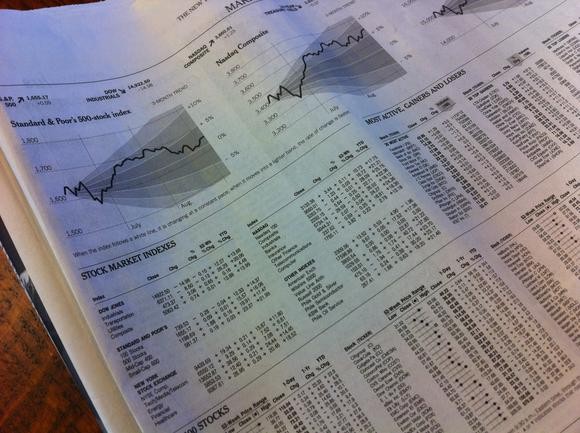How To Pick A Stock
Post on: 30 Март, 2015 No Comment

So you finally decided to start investing. You know that a low P/E ratio is generally better than a high P/E ratio, your portfolio should be diversified across multiple sectors, a company with a lot of cash on its balance sheet is superior to one excessively burdened with debt, and analysts’ recommendations should always be taken with a grain of salt. Now that you have all the fundamentals of investing mastered, and perhaps even studied the more complicated concepts of technical analysis. you are ready to pick stocks. (For additional reading, refer to Investing 101 .)
But wait! With tens of thousands of stocks to choose from, how do you go about actually selecting an equity investment? Going through every balance sheet and income statement out there to see which companies have a favorable net debt position and are improving their net margins is an impossible feat. Furthermore, choosing an investment based strictly on the criteria inputs of a stock screener is prone to error and does not produce a full representation of the company. Finally, simply coattailing institutional investors will usually not help you find any ten baggers as fund managers tend to focus primarily on safe blue chip stocks.
Determine Your Goals
The first step to actively picking out a stock from the sea of available alternatives is to determine what the purpose of your portfolio is. Investors focused on income, capital preservation or capital appreciation requirements will have different investment criteria. Income-oriented investors will usually focus on low-growth firms in industries and sectors such as the utilities, although other alternatives such as REITs and master limited partnerships are also readily available. Those who have a low risk tolerance and are primarily concerned with capital preservation tend to invest in stable blue chip corporations. And investors who are looking for capital appreciation should target companies of ranging market caps and life cycle stages. (To learn more, check out The Stock Cycle: What Goes Up Must Come Down .)
Keeping diversification in mind, any one of the aforementioned investor types could use a combination of the above strategies. However, deciding which category you fall under is the easy part; figuring out what stocks to actually pick is where the process becomes more complicated. Although there is no single correct method on how to go about picking stocks, a basic strategy should help investors narrow down their search before they start analyzing the financials of a firm.
Keep Your Eyes Open
In order to be an informed investor, it is essential to be up to date with current market events and opinions. Reading blogs, magazines and online financial news is a simple form of passive research which can be done on a daily basis. Sometimes, a news article or blog post will form the foundation of the underlying investment thesis.
For example, reading a newspaper article about a major acquisition can spur further research into the fundamentals which drive that particular industry. The internet provides a tremendous level of convenience whereby any major event will be analyzed through multiple perspectives by different investment professionals. Sometimes, the underlying argument can be as simple as there is currently a movement away from poverty in the emerging markets which is causing an increased number of people to cross the border into middle class status — as a result, there will be a surge in demand for product/commodity X. Taking this argument one step further, the investor can deduce that with an increase in the demand for X, producers of X will likely prosper.
This type of basic analysis forms the basis of the overall story behind the investment, which justifies purchasing any stock in the specific industry of interest. An important research requirement is to scrutinize the assumptions and theories of the original argument: if the supply of X is infinite, an upward demand push will likely have minimal effects on companies in the business of selling/producing X. Once you are comfortable and convinced of the general argument after performing this form of qualitative research, corporate press releases and investor presentation reports are a good place for continued analysis. (Cut through the information clutter and decipher the useful news from the useless. Check out Financial Media 4-1-1 For Investors .)
Finding Companies
The next stage in the stock picking process involves finding the companies which you may be potentially interested in. There are three simple ways of going about this task:
1. Find the ETFs which track the performance of the industry and check out their holdings. This can be as easy as just searching for Industry X ETF; the official ETF page will disclose either all or only the top holdings of the fund.
2. Use a screener to filter stocks based on specific criteria such as sector and industry. Screeners offer users additional features such as sorting companies based on market cap, dividend yield and other useful investment metrics.
3. Continue searching through the blogosphere, stock analysis articles and financial news releases for ideas on companies in the chosen investment space. Remember to be critical of everything you read and analyze both sides of the argument.

The three aforementioned methods are by no means the only ways on how to pick a company, but they do offer an easy way to start. There are also clear advantages and disadvantages associated with each strategy that investors should take note of.
Searching for companies based on ETF holdings is probably the quickest way of narrowing down your search. However, ETFs typically hold only the largest companies in the space, often ignoring micro and small cap corporations. These types of funds also tend to focus on domestic markets. Stock screeners offer a very efficient alternative to narrow down the list of companies subject to desired inputs. Although screeners provide a more comprehensive list of securities which includes international firms, the investment metrics which are presented are often somewhat misleading. Seeking out experts’ opinions via news sources is the most time consuming alternative, but it undoubtedly carries significant advantages. Firstly, reading stock analysis pieces will further your understanding on industry fundamentals. Secondly, investors will often come across junior companies which can neither be found through screeners or within ETF holdings. Finally, research at this stage cuts down your subsequent research time later on in the stock-picking process.
Turn to Corporate Presentations
Once you are convinced that Industry X is a solid investment and you are familiar with the major players, it is time to turn your attention to investor presentations. Although presentations are less comprehensive than financial statements. they provide a general overview of how firms make their money and are much easier to browse through than 10-Q and 10-K reports. Additionally, presentation reports will usually have forward-looking information on the expected direction of the company and its industry. While the previous tips of going through fund holdings or performing a screen will produce a large number of potential equity investment options, looking through company websites and presentations lets you further refine your search. This stage of stock picking becomes more active.
The information of an investor presentation report includes such material as balance sheet/income statement/cash flow statement performance, operational highlights, future growth opportunities and a general industry overview. Analyzing presentations involves more in-depth scrutiny of the actual company in order to decide why a particular stock is likely to outperform one of its competitors. Investors must now determine which companies are most attractive based on the presented information and narrow down their search once again. A key consideration is that the purpose of an investor presentation report is to give the company a chance to put its best foot forward.
The Bottom Line
At this point you could be left with only a single investment prospect or a list of 10 or more companies. Perhaps, even after all the time you put into finding a stock, you decided that this industry is not right for you. This sort of decision is vital to the art of stock picking since your research has helped prevent a potentially sour investment.
If you are still convinced of your original thesis, your research should now focus on in-depth financial statement analysis. (Learn about the components of the statement of financial position and how they relate to each other. See Reading The Balance Sheet .)














